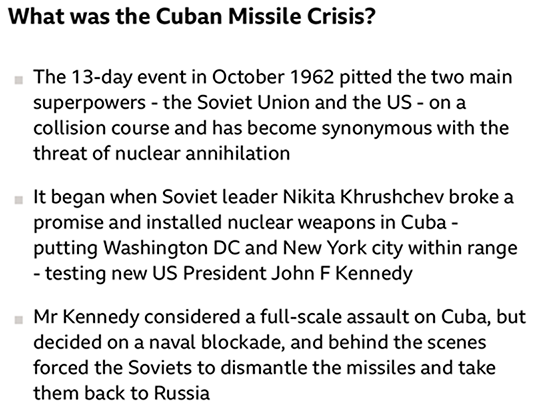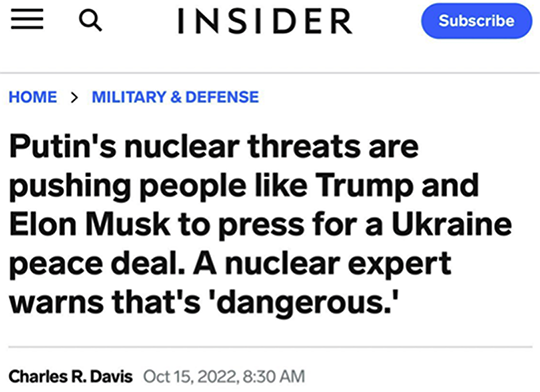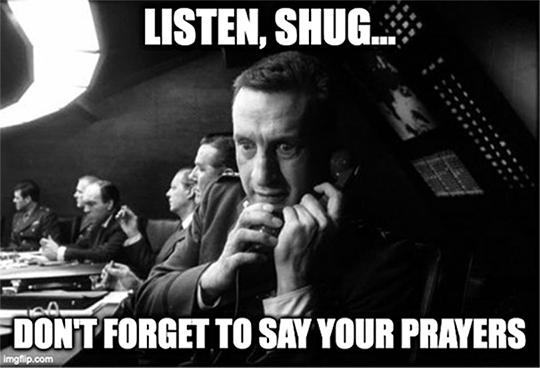Avoidable Armageddon
![]() From “the Daisy Ad”... to “Strikes Inside Russia”
From “the Daisy Ad”... to “Strikes Inside Russia”
 We’re a few days late marking the 60th anniversary of a legendary campaign commercial — by some accounts, the most famous in history.
We’re a few days late marking the 60th anniversary of a legendary campaign commercial — by some accounts, the most famous in history.
The “daisy ad” aired only once — on the evening of Monday, Sept. 7, 1964. NBC was airing the 1951 Technicolor epic David and Bathsheba, starring Gregory Peck as King David.
“The ad began with an adorable 3-year-old girl counting petals as she pulled them from a daisy,” recalls the media critic and antiwar activist Norman Solomon.

“Then came a man’s somber voiceover, counting down from 10 to zero. Then an ominous roar and a mushroom cloud from a nuclear bomb explosion.”
The ad for the incumbent president Lyndon Johnson cemented the perception that his opponent — the conservative firebrand Barry Goldwater — might casually consign the world to nuclear oblivion. LBJ went on to win 44 states and a staggering 61% of the popular vote.
Even as he ramped up a proxy war against the Soviet Union in Vietnam… LBJ made sure to dial down the nuclear tension. During 1967 he met with Soviet Premier Alexei Kosygin for a summit in Glassboro, New Jersey.
In the 1970s, Richard Nixon signed a landmark treaty with Soviet Russia. So did Ronald Reagan in the 1980s — recognizing, as he said more than once, that “a nuclear war can never be won and must never be fought.”
 Fast-forward to this morning and…
Fast-forward to this morning and…


According to Politico, “Officials in Washington, London and Kyiv have in recent days discussed expanding the area inside Russia that Ukraine can hit with American- and British-made weapons.”
Russian President Vladimir Putin says if true, “it would mean that NATO countries, the U.S., European countries, are at war with Russia.”
And what would he do about that? Putin is purposely ambiguous: “We will take the appropriate decisions based on the threats that we will face.”
Presumably Biden administration officials would say Putin is bluffing. That’s what they’ve said every time they’ve escalated the conflict with Russia over Ukraine — giving them the confidence to escalate again and again. But at some point, Putin will hit back in a manner of his choosing.
To be sure, we’re straying a bit from our usual financial beat today.
But as I’ve said for several years now, the issue of U.S.-Russia relations eclipses everything else: There won’t be any markets or economy for us to talk about if the Earth is pockmarked with smoldering radioactive craters.
 It’s staggering to think about: The risk of Armageddon is at least as high, if not higher, than it was at the height of the Cuban Missile Crisis.
It’s staggering to think about: The risk of Armageddon is at least as high, if not higher, than it was at the height of the Cuban Missile Crisis.
On Oct. 22, 1962, President John F. Kennedy went on TV. He told the American people that the Soviet Union had deployed nuclear missiles in Cuba. The missiles, he said, posed “an explicit threat to the peace and security of all the Americas.”
He issued an ultimatum to the Soviet leader Nikita Khrushchev, demanding the missiles be pulled out — which, after a few more days and a U.S. naval blockade of Cuba, Khrushchev agreed to do.
![]() The Truth About the Cuban Missile Crisis
The Truth About the Cuban Missile Crisis
 “Everything you think you know about those 13 days is wrong,” said the subhead to a 2013 article by Benjamin Schwarz in The Atlantic.
“Everything you think you know about those 13 days is wrong,” said the subhead to a 2013 article by Benjamin Schwarz in The Atlantic.
Schwarz’s article was a sorely needed corrective to the official mythology. But on the 60th anniversary in 2022, Establishment media were reciting the mythology again. You might even call it “misinformation” — were it not for the fact that Establishment media have hijacked that word to mean “something that runs counter to mainstream narratives.”
So here’s some real misinformation — omitting critical context — in an “explainer” about the Cuban Missile Crisis published by the BBC during the 2022 anniversary…

This is the narrative the U.S. government put out well into the 1970s and ’80s — and the narrative that lingers in popular memory.
“Officially,” Brown University senior fellow Stephen Kinzer writes in The Boston Globe, “the Soviets agreed to withdraw their missiles in exchange for nothing more than an American pledge not to invade Cuba.
“Americans were jubilant over what seemed like total victory... This was the false lesson that Secretary of State Dean Rusk sought to propagate when he summed up the result by saying, ‘We were eyeball-to-eyeball and the other fellow just blinked.’
 “The carefully concealed truth did not emerge for more than a decade,” Kinzer continues.
“The carefully concealed truth did not emerge for more than a decade,” Kinzer continues.
“Kennedy, it turns out, had made a secret deal with Khrushchev. He promised to remove U.S. nuclear missiles from Turkey in exchange for the Soviet removal of missiles from Cuba. So the crisis was ended not by threats of force, as Rusk suggested, but by the precise opposite: diplomatic compromise.
“That is the urgent message Washington and Moscow must heed as we careen toward another nuclear crisis in Ukraine.”
 Instead… the myth of the Cuban Missile Crisis endures, the facts be damned.
Instead… the myth of the Cuban Missile Crisis endures, the facts be damned.
As Schwarz wrote in his Atlantic article, “By successfully hiding the deal from the vice president, from a generation of foreign-policy makers and strategists and from the American public, Kennedy and his team reinforced the dangerous notion that firmness in the face of what the United States construes as aggression, and the graduated escalation of military threats and action in countering that aggression, makes for a successful national-security strategy — really, all but defines it.”
Key point: JFK and his advisers pursued diplomatic compromise in spite of how they perceived the installation of the missiles.
“Khrushchev could not miss the fact that what he had attempted to do was viewed in Washington as an existential threat,” writes Ray McGovern, a 27-year CIA veteran who ran the agency’s Soviet foreign policy branch. [Emphasis his.]
“Equally important, the Soviet leadership were able to appreciate that removing the missiles, however embarrassing, would constitute no existential threat to the Soviet Union.”
 “The greatest lesson from Cuba was the peril of brinkmanship,” historians Stephen Ambrose and Douglas Brinkley wrote in the 1997 edition of their book Rise to Globalism.
“The greatest lesson from Cuba was the peril of brinkmanship,” historians Stephen Ambrose and Douglas Brinkley wrote in the 1997 edition of their book Rise to Globalism.
“Henceforth, Russia and America would strive to keep some control over their disputes, to avoid actions that could lead to escalations, to limit their commitments so that they could limit the other side’s response.”
There were still close calls during the rest of the Cold War — especially in the early 1980s, when the Doomsday Clock reached three minutes to midnight — but open lines of communication kept the peace.
![]() America’s “Thought Leaders” Have Learned NOTHING
America’s “Thought Leaders” Have Learned NOTHING
 Alas that lesson is lost on America’s power elite six decades later — as we saw in this 2022 headline from one of the major business-news websites…
Alas that lesson is lost on America’s power elite six decades later — as we saw in this 2022 headline from one of the major business-news websites…

And as we saw in tweets from a Yale history professor…

What a deranged mindset: Well, yeah, it’s too bad tens of millions of Americans glow in the dark now. But Putin sure got owned, so it was totally worth it!
 In contrast with the Cuban Missile Crisis, the shoe is on the other foot: It's Russia that perceives the existential threat.
In contrast with the Cuban Missile Crisis, the shoe is on the other foot: It's Russia that perceives the existential threat.
“Putin,” writes McGovern, “has warned repeatedly of the existential threat he believes Russia faces from what Russia calls ‘offensive strike missiles’ like the Tomahawk and, eventually, hypersonic missiles along its western border.”
Throughout 2021 and early 2022, Putin sought guarantees from Joe Biden that Washington and the NATO alliance would not deploy such systems on Russia’s doorstep in Ukraine. The subject came up whenever the two spoke to each other.
The Kremlin says during the last of those discussions on Feb. 12, 2022, Putin “received no meaningful response.” Russia invaded Ukraine 12 days later.
In May 2022, CIA Director William Burns — the most sober and knowledgeable Russia hand in the Biden administration — said he thought Putin was “in a frame of mind in which he doesn’t believe he can afford to lose.” Again, the existential threat.
![]() Avoidable Armageddon
Avoidable Armageddon
 And so Armageddon hangs over all of us.
And so Armageddon hangs over all of us.
As Cato Institute scholar Ted Galen Carpenter wrote in 2022, “Russian officials have signaled on multiple occasions that while the Kremlin has no current plans to use even small, tactical nuclear weapons to end the military stalemate in Ukraine, Vladimir Putin’s government reserves the right to use nukes if Russia’s independence or territorial integrity is threatened.”
Once more, the existential threat. No small thing when Joe Biden ad-libbed during the early days of the conflict, “For God’s sake, this man cannot remain in power.”
But in his occasional lucid moments, Biden seems to grasp the stakes. In October 2022, for instance, he mused about how Putin needs an “off-ramp” to forestall “the prospect of Armageddon.”
He did not, however, say this in a speech to the American people to marshal their support for diplomatic compromise. He said it behind closed doors to a group of wealthy campaign donors in New York for reasons known only to himself.
Unless there are backchannel discussions we don’t know about, no one in Washington is actually proposing an off-ramp to Putin. While Kennedy and Khrushchev exchanged telegrams several times during those 13 days in October 1962, Biden and Putin haven’t spoken once since the invasion — in February 2022.
Because that would be “dangerous” and giving in to “nuclear blackmail,” apparently.
 “Let me flatly state what should be obvious: There is nothing in the conflict between Russia and Ukraine that is worth the loss of one NATO or American city to a nuclear blast. Period. Full stop.”
“Let me flatly state what should be obvious: There is nothing in the conflict between Russia and Ukraine that is worth the loss of one NATO or American city to a nuclear blast. Period. Full stop.”
So writes retired Army combat officer Daniel L. Davis, now a senior fellow at the Defense Priorities think tank.
“This reality should immediately inform a reevaluation of Washington’s policies and the adoption of new objectives. The Constitution places no higher obligation on Congress and the president than to defend our country and protect our ability to prosper as a nation. Courting an avoidable nuclear disaster — especially when our security is not threatened — should never be on the table.” [Emphasis ours.]
In 1962, adds Ted Galen Carpenter, “the Kremlin wisely concluded that the United States would not back down from even a nuclear confrontation, but would go to war to prevent such a threat to its vital interests.
“This time, Washington is the party that needs to back away from a spiraling confrontation before it’s too late.”
And if it does not?
![]() If the Worst Does Happen…
If the Worst Does Happen…
 We try in these daily missives to not only reveal hidden truths but to give you something to do about them. An ETF to buy. A sector to avoid. Or, often as not, clicking on one of our sales promotions to learn more.
We try in these daily missives to not only reveal hidden truths but to give you something to do about them. An ETF to buy. A sector to avoid. Or, often as not, clicking on one of our sales promotions to learn more.
But when Armageddon looms? What practical course of action is there? Apart from the advice of Gen. Buck Turgidson in Dr. Strangelove, that is…

Political action? We wish folks like these the best, but we’re not hopeful. This isn’t June 1982 — when up to a million people gathered in New York’s Central Park to demand nuclear disarmament. Five years later, they won half a loaf when Ronald Reagan and Mikhail Gorbachev eliminated an entire class of nukes from the European continent.
No, in fact, in July 2022, New York City’s government alarmed people both inside and outside the five boroughs with a baffling public service announcement.
It began with a chirpy young woman saying, “So, there’s been a nuclear attack. Don’t ask me how or why, just know that the big one has hit.”

After 90 seconds of nigh-useless tips, it ends with her saying “All right? You’ve got this!”
As author and futurist Marshall Brain quipped, “A million people are dead, much of the city is rubble, there is radioactive dust everywhere, but you’ve got this!”
 During the Cold War, there was a peculiar contingent of people who organized their lives around the proposition Nuclear war is survivable, actually.
During the Cold War, there was a peculiar contingent of people who organized their lives around the proposition Nuclear war is survivable, actually.
Their prophet was Edward Teller, the Stranglovian physicist sometimes referred to as “the father of the hydrogen bomb.”
And their scripture was a 1979 book called Nuclear War Survival Skills, written by Oak Ridge National Laboratory researcher Cresson Kearny (with a foreword by Teller).
Much of what you find on the web that deals with surviving nuclear warfare can be traced back to Kearny’s book. And while I’m sure there’s some value to that information, following through on it seems like a full-time job — which is a problem if, like me, you’ve already got a full-time job.
 And so I’ve settled for some minimal precautions. My wife and I live in a rural area (good) that happens to be a few hundred miles downwind from all the intercontinental ballistic missile sites in the Northern Great Plains (bad).
And so I’ve settled for some minimal precautions. My wife and I live in a rural area (good) that happens to be a few hundred miles downwind from all the intercontinental ballistic missile sites in the Northern Great Plains (bad).
“These intercontinental ballistic missiles, or ICBMs, are not meant to be launched, ever,” wrote Tom Collina at the Defense One website in 2017. “Not even in a nuclear war. Their primary mission is to be destroyed in the ground, along with all the people that live anywhere near them. Their main purpose is to ‘absorb’ a nuclear attack from Russia, acting as a giant ‘nuclear sponge.’ Such is the twisted logic of atomic warfare.”
When Russia invaded Ukraine in February 2022, there was a run on potassium iodide tablets… but I hunted around online long enough to source a supply of IOSAT 130 mg tablets for the two of us. With the initial scare long since over, they’re easier to get now. You might even find them marked down from the regular price. Pay heed to the expiration date — typically five–eight years out.
I also got a NukAlert radiation monitor. Supposedly federal employees keep these things on their keyrings. However, it generates a constant slight ticking noise, so mine is stuffed inside an Altoids tin that’s part of my everyday-carry backpack. They’re readily available online. At the moment, Walmart has a better price than Amazon. (Maybe it’s a National Preparedness Month special?)
I imagine a Tellerite will email me after today’s missive to say YOU’RE DOING IT WRONG — but at this time that’s the tradeoff I’m making between the threat and the available time/money I’ve got to deal with the threat. Your mileage may vary.
 And maybe a little bit of prayer couldn’t hurt — prayer that present-day leaders will come to realize what JFK and Khrushchev did after those 13 days in October 1962.
And maybe a little bit of prayer couldn’t hurt — prayer that present-day leaders will come to realize what JFK and Khrushchev did after those 13 days in October 1962.
As Khrushchev reflected a few months later, “What good would it have done me in the last hour of my life to know that, though our great nation and the United States were in complete ruins, the national honor of the Soviet Union was intact?"
We give JFK the last word. From his landmark speech at American University in June 1963: “In the final analysis, our most basic common link is that we all inhabit this small planet. We all breathe the same air. We all cherish our children’s future. And we are all mortal.”
P.S. Hat tip to the Australian writer and media critic Caitlin Johnstone — whose trenchant articles furnished a handful of sources I scraped for this edition.
P.P.S. As for the markets today, nearly everything is rising after the Federal Reserve planted a story with Wall Street Journal reporter Nick Timiraos — the Fed’s preferred conduit for authorized leaks.
The gist is that the Fed might “go big” next week when cutting interest rates after all. In the futures markets, there’s now a nearly 50-50 chance the Fed will cut the benchmark fed funds rate by a half percentage point — not just a quarter.
With that as the backdrop, all the major U.S. stock averages are in the green — the S&P 500 at 5,619, less than 1% off its all-time high two months ago. Bond prices are also moving higher, sending yields lower; at 3.67% the 10-year Treasury yield is approaching its 2024 lows.
Gold is reaching toward record territory at $2,577. Silver is solidly above $30 again. Crude is back above $70. Bitcoin is over $58K for the first time in over a week.
We’ll have much more to say next week as the Fed embarks on its first rate-cutting cycle in five years. For now, we’ll just say this: There’s one market niche in particular you’ll want to consider putting your money into for the rest of this year and into 2025. The resulting gains could be life-changing.










